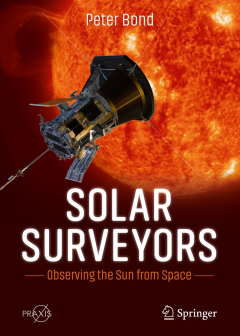Solar Surveyors: Observing the Sun from Space
| By Peter Bond | Reviewed by Martin Edmonds |
| Springer Praxis Books 2022 | 549 pages |
| Price £27.99 | ISBN:978-3-030-98787-9 |

Peter Bond’s most recent book recounts humanity’s efforts to observe and understand our neighbouring star and its impact on both Earth and the wider solar system.
The book is divided into eight sections. The first chapter provides a good general overview of key topics in solar research, including the solar spectrum, solar magnetism and the history of early solar astronomy. Whilst much of this will be familiar to some readers, it sets a clear starting point for the rest of the book and will be a useful resource for many.
The second chapter describes the structure of the Sun, from the inner core to the chromosphere and corona. A very large amount of information is packed into this chapter, but the use of subsections, frequent diagrams and impressive images prevents this from becoming overwhelming to the reader. Approaches to observing the Sun are presented in the third chapter and this covers ground-based observatories, atmospheric balloons and space observatories.
Chapter four presents a fascinating overview of the many spacecraft which have ventured beyond Earth’s gravitational and magnetic influence to survey the solar system. By beginning with the ion trap instruments carried on the Luna probes, which made the first direct observations of the solar wind, Bond demonstrates how our understanding of the Sun has developed through each mission, presenting a gradually unfolding picture of our appreciation of our neighbouring star.
The major space observatories which have been dedicated primarily to solar studies are covered in the fifth chapter, including the OSO (Orbiting Solar Observatory) series and Japan’s Hinotori and Yohkoh observatories, as well as the Earth-orbiting CORONAS (Comprehensive Orbital Near-Earth Observations of the Active Sun) satellites. The ESA-NASA SOHO (Solar and Heliospheric Observatory) spacecraft has now been operational for 26 years; the book offers a concise overview of its work and achievements to date.
Crewed missions involved in solar studies are presented in chapter six, including the Skylab ATM (Apollo Telescope Mount) programme and the more recent TSIS-1 (Total and Spectral Solar Irradiance Sensor) mission to measure the Sun’s energy output to Earth. A concluding chapter presents an overview of future planned missions which focus wholly, or partly, on solar astronomy. This offers an especially useful reference guide to current work and the possible direction of future research.
The book is illustrated throughout with colour diagrams, pictures and charts. Each chapter ends with references and an index is included; these make the volume easy to use and provide ways for the reader to engage further with this fascinating subject.
Peter Bond will be familiar to many readers as the author of 13 previous books (and innumerable articles) on astronomical topics. He has also worked as the space science advisor and press officer for the Royal Astronomical Society, and his depth of experience is evident in his writing. He has both a deep appreciation of the subject and the ability to communicate complex ideas clearly and concisely.
As well as being an enjoyable read, this is destined to become a valuable reference work on the history of solar observation. Solar Surveyors is a highly readable and informative book, covering our attempts to observe and understand the most dominant object in our solar system. Highly recommended
Dr Martin Edmonds has a particular interest in solar and lunar astronomy and was awarded the BAA’s 2017 Sir Patrick Moore Prize.
| The British Astronomical Association supports amateur astronomers around the UK and the rest of the world. Find out more about the BAA or join us. |
